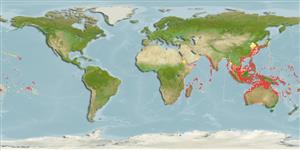Environment: milieu / climate zone / depth range / distribution range
Ecologia
marinhas; estuarina associadas(os) a recifes; não migratória; intervalo de profundidade 1 - 100 m (Ref. 9661), usually 1 - 50 m (Ref. 90102). Tropical; 42°N - 35°S, 18°E - 123°W
Indo-Pacific: Red Sea (Ref. 12541) and East Africa (Ref. 12484) to the Marquesan and Tuamoto islands, north to southern Japan, south to Lord Howe Island (Ref. 9710).
Tamanho / Peso / Idade
Maturity: Lm ? range ? - ? cm
Max length : 46.0 cm TL macho/indeterminado; (Ref. 3141); common length : 40.0 cm TL macho/indeterminado; (Ref. 9661)
Descrição breve
Chaves de identificação | Morfologia | Morfometria
Espinhos dorsais (total) : 0; Raios dorsais moles (total) : 8 - 9; Espinhos anais: 0; Raios anais moles: 8 - 9. Cryptic coloring ranges from green and olive to orange with blue spots (Ref. 3141). Caudal fin rays 9-10 (Ref. 1602).
Inhabit inshore on coastal muddy or sandy habitats in still bays, and commonly found in harbours and estuaries. Small juveniles on protected shallow mudflats (Ref. 48637). Found in weedy areas near rocks or reefs. Juveniles often near river mouths and in brackish water. Adults are solitary, juveniles often form small groups (Ref. 1602). Large adults are shy (Ref. 48637). Feed on benthic invertebrates by blowing away the sand (Ref. 1602). Readily dried and used to make ornaments (Ref. 12484).
Life cycle and mating behavior
Maturidade | Reprodução | Desova | Ovos | Fecundidade | Larvas
Randall, J.E., G.R. Allen and R.C. Steene, 1990. Fishes of the Great Barrier Reef and Coral Sea. University of Hawaii Press, Honolulu, Hawaii. 506 p. (Ref. 2334)
Categoria na Lista Vermelha da IUCN (Ref. 130435: Version 2024-1)
Ameaça para o homem
Reports of ciguatera poisoning (Ref. 4690)
Utilização humana
Pescarias: sem interesse; Aquário: Espécies comerciais
Ferramentas
Relatórios especiais
Descarregue XML
Fontes da internet
Estimates based on models
Preferred temperature (Ref.
123201): 21.9 - 28.4, mean 27.2 °C (based on 532 cells).
Phylogenetic diversity index (Ref.
82804): PD
50 = 0.5625 [Uniqueness, from 0.5 = low to 2.0 = high].
Bayesian length-weight: a=0.01995 (0.01177 - 0.03383), b=2.77 (2.62 - 2.92), in cm total length, based on LWR estimates for this species & (Sub)family-body (Ref.
93245).
Nível Trófico (Ref.
69278): 3.5 ±0.37 se; based on food items.
Resiliência (Ref.
120179): Elevada, tempo mínimo de duplicação da população menor que 15 meses (Fec assumed to be > 10,000).
Fishing Vulnerability (Ref.
59153): Moderate vulnerability (36 of 100).
Nutrients (Ref.
124155): Calcium = 34.3 [14.7, 91.1] mg/100g; Iron = 0.579 [0.299, 1.289] mg/100g; Protein = 18.6 [16.4, 20.8] %; Omega3 = 0.126 [0.066, 0.240] g/100g; Selenium = 44.7 [22.1, 94.7] μg/100g; VitaminA = 36.7 [9.9, 143.1] μg/100g; Zinc = 1.13 [0.75, 1.68] mg/100g (wet weight);
